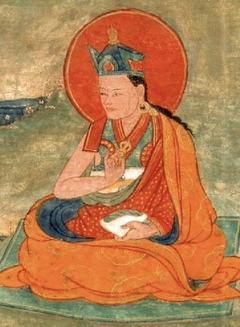Heart Advice in a Nutshell
Heart Advice in a Nutshell[1]
from The Essential Amrita of Profound Meaning: Oral Instructions and Practical Advice Bestowed Upon Fortunate Followers, Eye-opener to What is to be Adopted and Abandoned
by Chokgyur Dechen Lingpa
Oṃ svasti!
The Dharma body of great emptiness pervades both saṃsāra and nirvāṇa.
The perfect enjoyment[2] of great bliss is luminous yet distinct.
The emanation body manifests in myriad ways for beings’ various needs.
I venerate, atop the crown of my head, the guru who embodies these three kāyas.
Your profound and vast qualities are boundless.
Your activities free beings from the ocean of karma and afflictions.
All connections with you are meaningful, bringing beings to the purified state.
Your attainment is simply amazing, unsurpassed.
By placing my mind, free of distraction, in that state beyond mind— Meditation beyond extremes on the profound, innate Dharma, With the perfect place, perfect time, perfect teacher, and perfect retinue— And by training one-pointedly in that, I can discover ultimate bliss and excellence, in this and future lives.
When the teacher and his entire retinue were seated in meditation in the Supreme sacred place of wisdom form, the solitary place named Kyijam Nyida, the guru, the great treasure-revealer, the king of Dharma, gave this oral instruction, which was then noted down:
At first, with a sincere longing to attain liberation, and with pure renunciation, go to a solitary place and find a cave. There, recall the Three Jewels and, if you wish, recite a liturgy for refuge. It is also okay not to, as the case may be. Then, exhale the stale breath three times, and imagine that your misdeeds and obscurations have been completely purified. Visualize the Lotus-Born Guru indivisible from your own gracious root guru on the crown of your head, and recite The Prayer in Six Vajra Lines once. Let the guru dissolve into yourself. Then begin the main part of the session and enter equipoise.
Beginners should first of all search for the mind’s stillness, movement, and awareness. Secondly, they should examine that which is looked at and the looker. Thirdly, they should let be, in equipoise, within the looker.
The way one recognizes is as follows. To recognize after three moments is the lesser recognition. To recognize after two moments is the middling recognition. To recognize after one moment is the best recognition. When one has the best kind of recognition, whatever thoughts arise should immediately vanish without trace as soon as you look at them. Then, by extending the duration of recognition you should become uninterrupted and unshaken by thoughts, like a lake during rainfall.
As for dispelling obstacles and enhancing, the main point is to reflect on impermanence and, in addition, to reflect on compassion, faith, pure perception, disenchantment, and renunciation. By doing so, a sense of the futility of samsaric pursuits and confidence in karmic cause and effect will naturally arise. For these thoughts to occur effortlessly is a sign that extraordinary realization has dawned within your mind.
When finishing the session, dedicate the virtue of having remained in meditation as the cause for all sentient beings, infinite in number, to attain awakening. Everything you have done in saṃsāra, from the very beginning until now, has been meaningless. But today the session of meditation you have done has been extremely meaningful, so you should arouse a deep-felt joy. Then, maintaining a joyful and vivid recollection of the great kindness of the guru and the Three Jewels, do not forget the practice as you undertake your daily activities.
Those of the very highest faculties rest solely in luminosity during meditative equipoise, and in post-meditation they train in compassion, etc. The yogin who has perfected the practice has no distinction between equipoise and post-meditation; everything is unity.
| Samye Translations, 2023.
Bibliography
Source Text
mchog gyur gling pa, “rjes ’jug skal bzang rnams la bstsal pa’i zhal gdams bslab bya nyams len gyi skor spang blang mig ’byed zab don snying gi bdud rtsi.” In mchog gling bka’ ’bum skor. Vol. 36 of mChog gling bde chen zhig po gling pa yi zab gter yid bzhin nor bu’i mdzod chen po, 108–111. Kathmandu, Nepal: Ka-nying Shedrub Ling Monastery, 2004.
Version: 1.0-20231107
